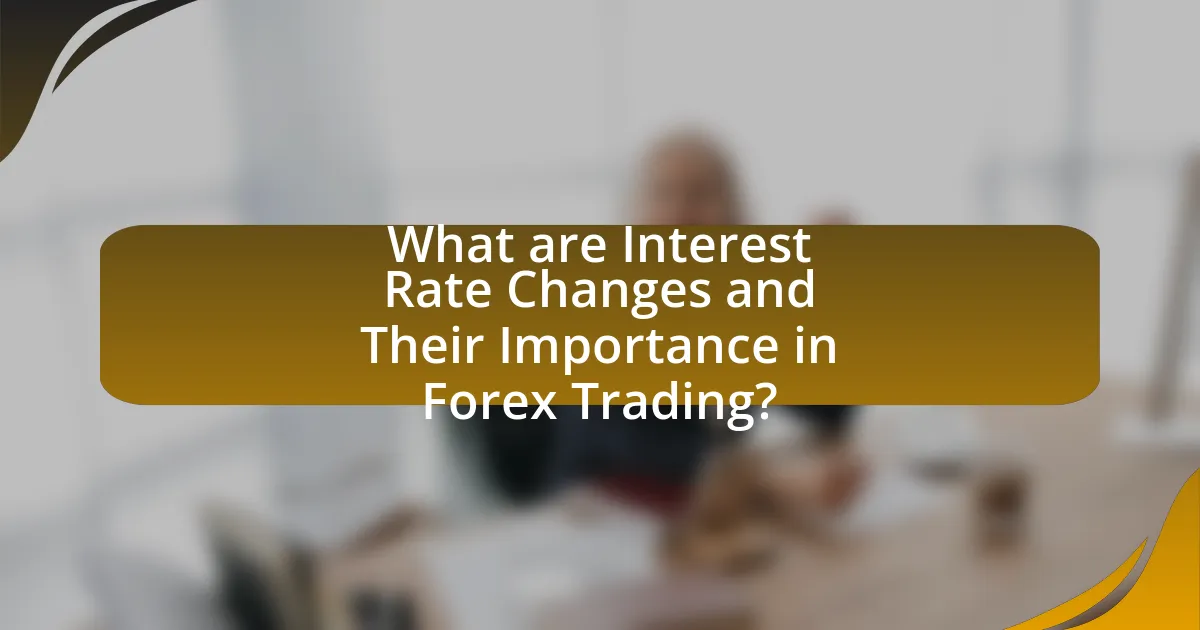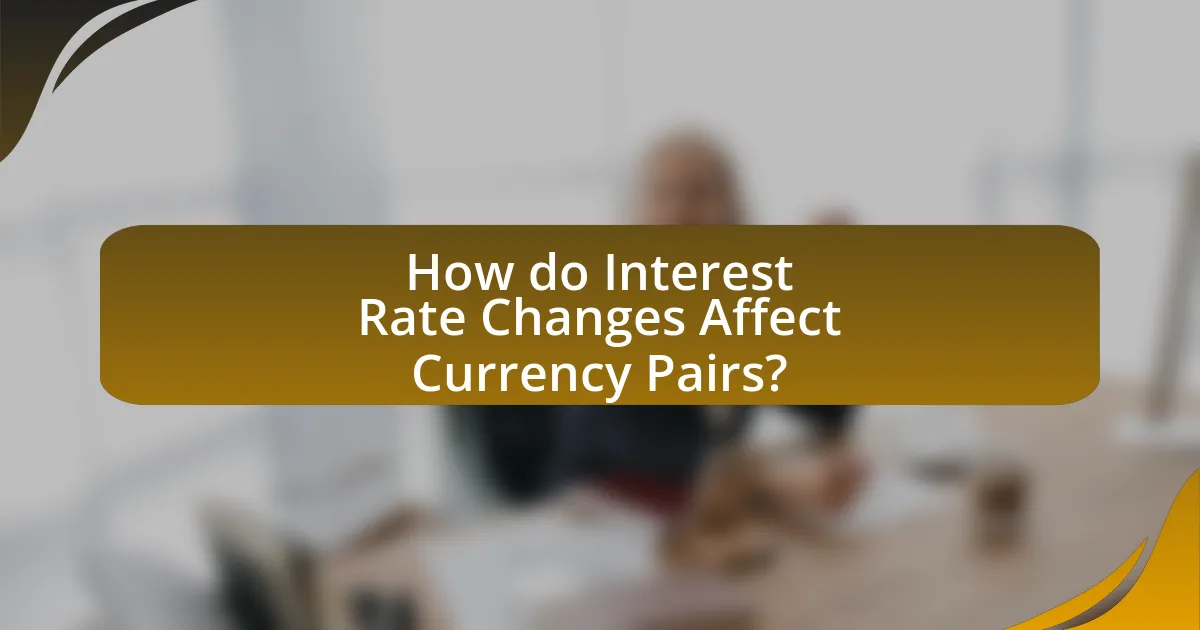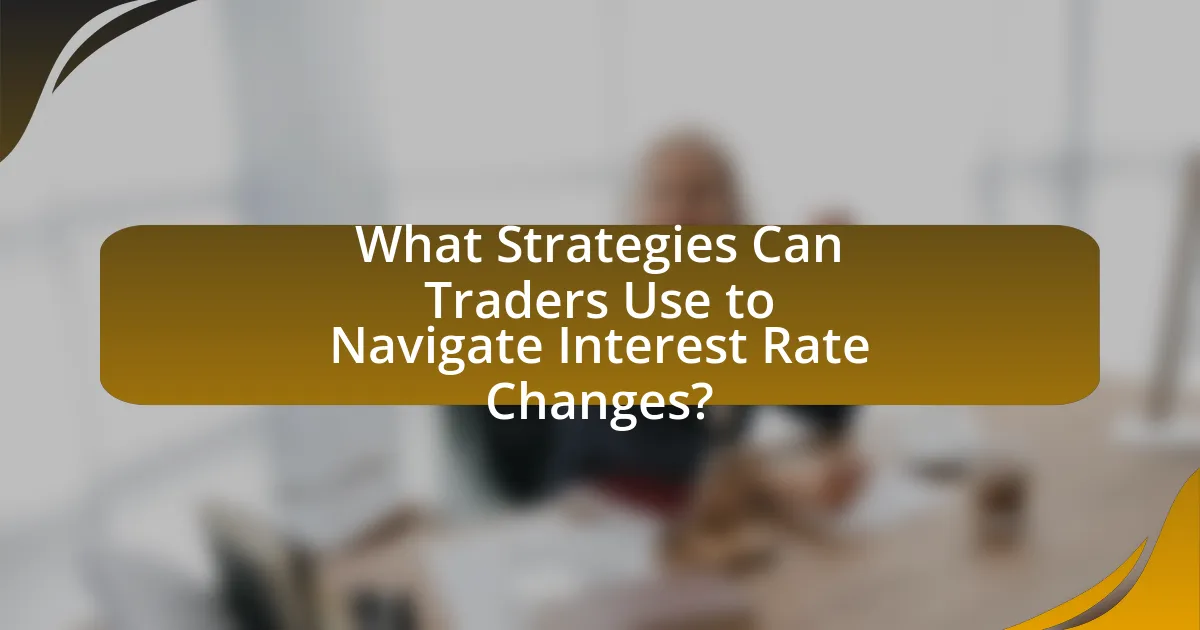Interest rate changes are adjustments made by central banks to benchmark interest rates, significantly impacting currency values in Forex trading. When interest rates rise, currencies typically strengthen due to increased foreign investment, while lower rates can lead to depreciation. The article explores the relationship between interest rates and currency values, the mechanisms of currency pair valuation, and the influence of economic indicators and geopolitical events on interest rate changes. Additionally, it discusses trading strategies, risk management techniques, and tools that traders can use to navigate the effects of interest rate fluctuations on currency pairs.

What are Interest Rate Changes and Their Importance in Forex Trading?
Interest rate changes refer to adjustments made by central banks to the benchmark interest rates that influence borrowing costs and economic activity. These changes are crucial in Forex trading because they directly impact currency values; when a central bank raises interest rates, it typically strengthens the currency as higher rates attract foreign capital, while lower rates can weaken the currency due to reduced investment appeal. For instance, the U.S. Federal Reserve’s interest rate hikes in 2015 led to a significant appreciation of the U.S. dollar against other currencies, demonstrating the direct correlation between interest rate changes and currency valuation in the Forex market.
How do interest rates influence currency values?
Interest rates directly influence currency values by affecting the flow of capital between countries. When a country raises its interest rates, it typically attracts foreign investment, as higher rates offer better returns on investments denominated in that currency. For example, in 2015, the U.S. Federal Reserve’s decision to increase interest rates led to a stronger U.S. dollar against other currencies, as investors sought higher yields. Conversely, when interest rates are lowered, capital may flow out of the country, leading to a depreciation of the currency. This relationship is supported by the interest rate parity theory, which states that differences in interest rates between two countries will be reflected in the exchange rates of their currencies.
What is the relationship between interest rates and inflation?
Interest rates and inflation have an inverse relationship; when interest rates rise, inflation typically decreases, and vice versa. Central banks, such as the Federal Reserve, adjust interest rates to control inflation. For example, in the 1980s, the U.S. raised interest rates to combat double-digit inflation, successfully reducing it to more manageable levels. This relationship is grounded in the principle that higher interest rates increase the cost of borrowing, leading to reduced consumer spending and investment, which in turn lowers demand and helps control inflation.
How do central banks set interest rates?
Central banks set interest rates primarily through monetary policy tools, particularly by adjusting the policy interest rate, which influences borrowing costs and economic activity. They analyze various economic indicators, such as inflation rates, employment levels, and GDP growth, to determine the appropriate rate that aligns with their economic objectives, such as price stability and full employment. For instance, the Federal Reserve in the United States uses the Federal Open Market Committee (FOMC) meetings to assess economic conditions and make decisions on interest rate adjustments, which directly impact currency values and market expectations.
Why do traders need to monitor interest rate changes?
Traders need to monitor interest rate changes because these changes directly influence currency values and market dynamics. When a central bank alters interest rates, it affects the cost of borrowing and the return on investments, leading to shifts in capital flows. For instance, a rise in interest rates typically strengthens a currency as it attracts foreign capital seeking higher returns, while a decrease can weaken it. Historical data shows that significant interest rate adjustments, such as the U.S. Federal Reserve’s rate hikes in 2015, resulted in notable fluctuations in the U.S. dollar’s value against other currencies, illustrating the critical impact of interest rates on currency pairs.
What impact do interest rate changes have on trading strategies?
Interest rate changes significantly impact trading strategies by influencing currency values and market sentiment. When a central bank raises interest rates, it typically strengthens the currency as higher rates attract foreign capital, leading traders to adjust their positions accordingly. Conversely, a decrease in interest rates can weaken a currency, prompting traders to shift their strategies to mitigate potential losses. Historical data shows that during the Federal Reserve’s rate hikes in 2015-2018, the U.S. dollar appreciated against major currencies, demonstrating how interest rate adjustments can drive trading decisions and market dynamics.
How can interest rate changes affect market volatility?
Interest rate changes can significantly affect market volatility by influencing investor behavior and economic expectations. When central banks alter interest rates, it impacts borrowing costs, consumer spending, and investment decisions. For instance, a rise in interest rates typically leads to higher borrowing costs, which can slow economic growth and increase uncertainty in the markets. This uncertainty often results in heightened volatility as investors react to changing economic conditions. Historical data shows that during periods of interest rate hikes, such as the Federal Reserve’s actions in 2018, stock market volatility increased, reflecting investor anxiety over potential economic slowdowns. Conversely, lower interest rates can stimulate economic activity, but may also lead to concerns about inflation, further contributing to market fluctuations.

How do Interest Rate Changes Affect Currency Pairs?
Interest rate changes significantly affect currency pairs by influencing capital flows and exchange rates. When a central bank raises interest rates, it typically attracts foreign capital, leading to an appreciation of that currency against others. For example, following the U.S. Federal Reserve’s interest rate hikes in 2015, the U.S. dollar strengthened against major currencies, reflecting increased investor interest in dollar-denominated assets. Conversely, when interest rates are lowered, capital may flow out, causing the currency to depreciate. Historical data shows that the euro weakened against the dollar after the European Central Bank cut rates in 2016, demonstrating the direct impact of interest rate changes on currency valuation.
What is the mechanism of currency pair valuation?
The mechanism of currency pair valuation is primarily determined by the relative value of two currencies, influenced by factors such as interest rates, economic indicators, and market sentiment. Currency pairs are quoted in terms of one currency against another, with the exchange rate reflecting how much of the quote currency is needed to purchase one unit of the base currency. For example, if the EUR/USD exchange rate is 1.20, it means 1 Euro can be exchanged for 1.20 US Dollars. Interest rates play a crucial role; higher interest rates in a country typically attract foreign capital, increasing demand for that country’s currency and thus appreciating its value relative to others. This relationship is supported by the interest rate parity theory, which states that the difference in interest rates between two countries will be reflected in the forward exchange rates.
How do interest rate differentials influence currency pair movements?
Interest rate differentials significantly influence currency pair movements by affecting capital flows between countries. When one country offers higher interest rates compared to another, it attracts foreign capital as investors seek better returns, leading to an appreciation of that country’s currency. For example, if the U.S. Federal Reserve raises interest rates while the European Central Bank maintains lower rates, the U.S. dollar may strengthen against the euro due to increased demand for dollar-denominated assets. Historical data shows that during periods of interest rate hikes, such as the U.S. rate increases in 2015-2018, the dollar appreciated against many currencies, illustrating the direct correlation between interest rate differentials and currency valuation.
What role does speculation play in currency pair fluctuations?
Speculation significantly influences currency pair fluctuations by driving demand and supply based on traders’ expectations of future price movements. When traders anticipate changes in interest rates, they often buy or sell currencies accordingly, leading to immediate price adjustments in currency pairs. For instance, if traders expect a central bank to raise interest rates, they may buy that currency, anticipating it will strengthen, which can cause its value to rise against other currencies. Historical data shows that during the 2015 Federal Reserve interest rate hike anticipation, the U.S. dollar appreciated significantly against other currencies, illustrating how speculation can lead to substantial fluctuations in currency pairs.
Why are some currency pairs more sensitive to interest rate changes?
Some currency pairs are more sensitive to interest rate changes due to the economic fundamentals and monetary policies of the countries involved. For instance, currency pairs involving major economies, like the US dollar and the euro, react strongly to interest rate adjustments because these changes directly influence capital flows, investment decisions, and inflation expectations. Historical data shows that when the Federal Reserve raises interest rates, the US dollar typically appreciates against other currencies, reflecting increased demand for dollar-denominated assets. This sensitivity is heightened in pairs where one currency has a significantly higher interest rate than the other, leading to greater investor interest in the higher-yielding currency.
What factors contribute to the volatility of specific currency pairs?
Factors contributing to the volatility of specific currency pairs include interest rate changes, economic indicators, geopolitical events, and market sentiment. Interest rate changes directly influence currency values; for instance, a rise in interest rates typically strengthens a currency as it offers higher returns on investments. Economic indicators, such as GDP growth and unemployment rates, provide insights into a country’s economic health, affecting currency stability. Geopolitical events, like elections or conflicts, can create uncertainty, leading to rapid fluctuations in currency values. Lastly, market sentiment, driven by trader perceptions and news, can cause sudden shifts in demand for currencies, further increasing volatility.
How do geopolitical events interact with interest rate changes in currency trading?
Geopolitical events significantly influence interest rate changes in currency trading by altering investor sentiment and economic stability perceptions. For instance, when a geopolitical crisis occurs, such as military conflict or political instability, it often leads to a flight to safety, prompting investors to favor currencies from stable economies, which can affect interest rates. Central banks may respond to these events by adjusting interest rates to stabilize their economies; for example, during the 2016 Brexit referendum, the uncertainty led to fluctuations in the British pound as the Bank of England considered interest rate cuts to support the economy. This interaction demonstrates that geopolitical events can create volatility in currency markets, directly impacting interest rate decisions and trading strategies.

What Strategies Can Traders Use to Navigate Interest Rate Changes?
Traders can navigate interest rate changes by employing strategies such as interest rate arbitrage, hedging, and adjusting their trading positions based on economic indicators. Interest rate arbitrage involves taking advantage of the differences in interest rates between countries, which can lead to currency appreciation or depreciation. For instance, if a trader anticipates an interest rate hike in a country, they may buy that currency to benefit from potential gains. Hedging strategies, such as using options or futures contracts, can protect against adverse movements in currency values due to interest rate fluctuations. Additionally, traders should closely monitor economic indicators like inflation rates and employment data, as these can signal potential interest rate changes and influence currency pairs. Historical data shows that currencies often react significantly to central bank announcements regarding interest rates, making it crucial for traders to stay informed and adjust their strategies accordingly.
How can traders anticipate interest rate changes?
Traders can anticipate interest rate changes by closely monitoring economic indicators, central bank communications, and market sentiment. Economic indicators such as inflation rates, employment figures, and GDP growth provide insights into the economic health that influences central bank decisions. For instance, if inflation rises above a target level, central banks may signal an upcoming rate hike to control inflation. Additionally, central banks often provide forward guidance during meetings, indicating their future policy intentions. For example, the Federal Reserve’s statements regarding economic outlook can lead traders to predict interest rate adjustments. Market sentiment, reflected in bond yields and currency movements, also serves as a barometer for anticipated changes; rising yields typically suggest expectations of higher rates. Thus, by analyzing these factors, traders can make informed predictions about future interest rate changes.
What economic indicators should traders watch for signals?
Traders should watch key economic indicators such as interest rates, inflation rates, employment data, GDP growth, and consumer confidence for signals. Interest rates directly influence currency values; for example, when a central bank raises rates, it typically strengthens the currency due to higher returns on investments. Inflation rates indicate purchasing power and can affect central bank policies; higher inflation may lead to rate hikes. Employment data, particularly non-farm payrolls, provides insight into economic health and can influence market sentiment. GDP growth reflects overall economic performance, impacting currency strength. Lastly, consumer confidence affects spending and investment, which can signal future economic activity. These indicators collectively provide a comprehensive view of economic conditions that traders rely on for making informed decisions.
How can historical data inform future interest rate expectations?
Historical data can inform future interest rate expectations by revealing patterns and trends in economic indicators that influence rate decisions. For instance, central banks often adjust interest rates in response to inflation rates, unemployment figures, and GDP growth, which can be analyzed through historical data. An example is the Federal Reserve’s actions during the 2008 financial crisis, where historical trends showed that lowering rates stimulated economic recovery, leading to a sustained period of low rates until 2015. This historical context allows economists and investors to anticipate future rate changes based on similar economic conditions, thereby enhancing the understanding of currency pair movements influenced by interest rate fluctuations.
What are the best practices for trading during interest rate announcements?
The best practices for trading during interest rate announcements include preparing for volatility, analyzing market expectations, and employing risk management strategies. Traders should closely monitor economic indicators leading up to the announcement, as these can influence market sentiment and expectations regarding interest rate changes. Historical data shows that currency pairs often experience significant price movements immediately following announcements; for example, the U.S. Federal Reserve’s interest rate decisions have historically led to average price swings of 100-200 pips in major currency pairs. Additionally, using stop-loss orders can help mitigate potential losses during these volatile periods, ensuring that traders protect their capital while taking advantage of market opportunities.
How can risk management techniques be applied during volatile periods?
Risk management techniques can be applied during volatile periods by implementing strategies such as diversification, hedging, and setting stop-loss orders. Diversification reduces exposure to any single asset, thereby mitigating potential losses; for instance, spreading investments across various currency pairs can buffer against adverse movements in one specific pair. Hedging involves taking offsetting positions in related assets, which can protect against unfavorable price changes; for example, using options or futures contracts can secure a price point for a currency pair. Setting stop-loss orders automatically limits losses by triggering a sale when a currency pair reaches a predetermined price, thus preventing further losses during sudden market shifts. These techniques are essential in maintaining capital and managing risk effectively during periods of high volatility, as evidenced by historical market data showing that disciplined risk management can lead to better long-term performance.
What tools and resources can assist traders in understanding interest rate impacts?
Traders can utilize economic calendars, financial news platforms, and analytical tools to understand interest rate impacts. Economic calendars provide scheduled announcements of interest rate decisions, allowing traders to anticipate market movements. Financial news platforms, such as Bloomberg and Reuters, offer real-time updates and expert analyses on interest rate changes and their implications for currency pairs. Additionally, analytical tools like trading platforms with built-in charting features enable traders to visualize historical interest rate trends and correlate them with currency fluctuations, enhancing their decision-making process.
